The Vegan Dressing Market is estimated to be valued at USD 1697.8 million in 2025 and is projected to reach USD 2872.7 million by 2035, registering a compound annual growth rate (CAGR) of 5.4% over the forecast period.
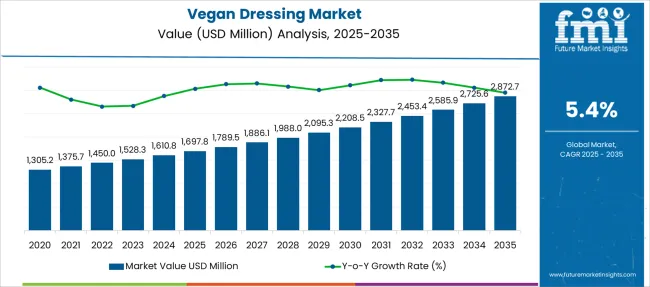
| Metric | Value |
|---|---|
| Vegan Dressing Market Estimated Value in (2025 E) | USD 1697.8 million |
| Vegan Dressing Market Forecast Value in (2035 F) | USD 2872.7 million |
| Forecast CAGR (2025 to 2035) | 5.4% |
The vegan dressing market is expanding rapidly, driven by growing consumer demand for plant-based and health-conscious food options. Shifts in dietary habits toward veganism and clean eating have encouraged food manufacturers to develop a wider range of vegan dressings that cater to flavor preferences and nutritional needs.
Increased awareness of the environmental and ethical benefits of plant-based diets has further accelerated market adoption. The residential segment is seeing higher consumption as more consumers prepare meals at home using healthier ingredients.
Retail trends reveal that indirect distribution channels such as wholesalers and food service suppliers play a crucial role in delivering vegan dressings to diverse points of sale. Innovation in flavor profiles and ingredient transparency are shaping consumer choices, while packaging developments improve product shelf life and convenience. Looking ahead, the market is expected to grow through product diversification and increasing penetration in both retail and foodservice sectors. Segmental growth is anticipated to be led by vinaigrettes as the preferred product type, residential applications driving demand, and indirect distribution channels dominating market reach.
The market is segmented by Product Type, Application, and Distribution Channel and region. By Product Type, the market is divided into Vinaigrettes, Mayonnaise, Ranch Dressing, Blue Cheese, Caesar Dressing, and Other Creamy Dressing. In terms of Application, the market is classified into Residential and Commercial. Based on Distribution Channel, the market is segmented into Indirect and Direct. Regionally, the market is classified into North America, Latin America, Western Europe, Eastern Europe, Balkan & Baltic Countries, Russia & Belarus, Central Asia, East Asia, South Asia & Pacific, and the Middle East & Africa.
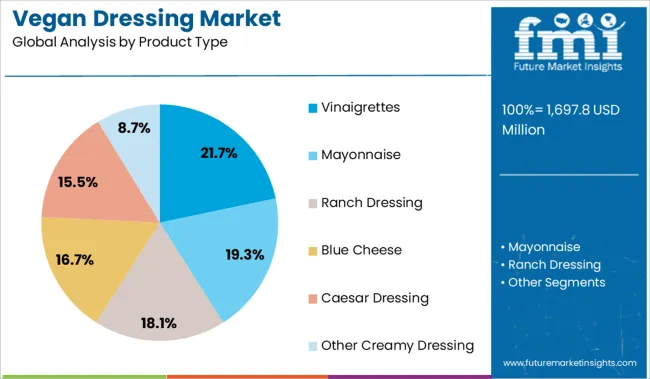
The vinaigrettes segment is projected to contribute 21.7% of the vegan dressing market revenue in 2025, maintaining its position as the largest product type segment. The appeal of vinaigrettes lies in their versatility as dressings, marinades, and flavor enhancers compatible with a wide range of cuisines.
Consumers have favored vinaigrettes for their fresh taste profiles and perceived health benefits, including lower fat content compared to creamy alternatives. The segment has benefited from innovation in natural and organic ingredients that enhance flavor without compromising vegan standards.
Additionally, the rising popularity of salad-based meals and plant-forward recipes has driven demand for vinaigrettes. Manufacturers have focused on clean label formulations and unique flavor blends to differentiate products, supporting segment growth. With consumers prioritizing both taste and health, the vinaigrettes segment is expected to remain a key market driver.
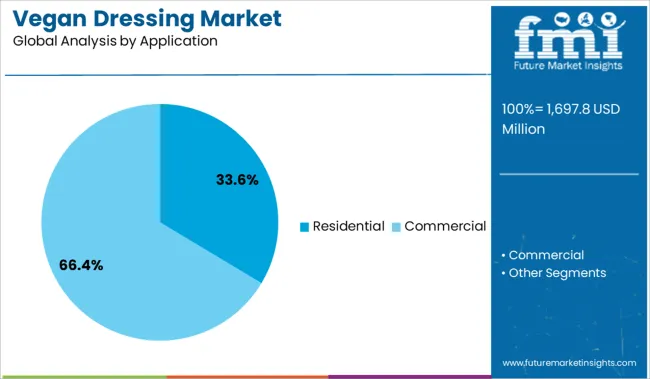
The residential segment is expected to account for 33.6% of the vegan dressing market revenue in 2025, positioning it as the leading application segment. This growth has been fueled by increased home cooking and meal preparation trends, especially post-pandemic when consumers have become more health-conscious.
The convenience and accessibility of vegan dressings have encouraged consumers to experiment with plant-based recipes at home. Social media and influencer-driven recipes have popularized vegan meal options, increasing demand for quality dressings.
Additionally, the availability of vegan dressings in mainstream grocery stores has made them accessible to a wider consumer base. The residential segment benefits from growing consumer awareness about diet and wellness, making it a critical factor in the market’s expansion.
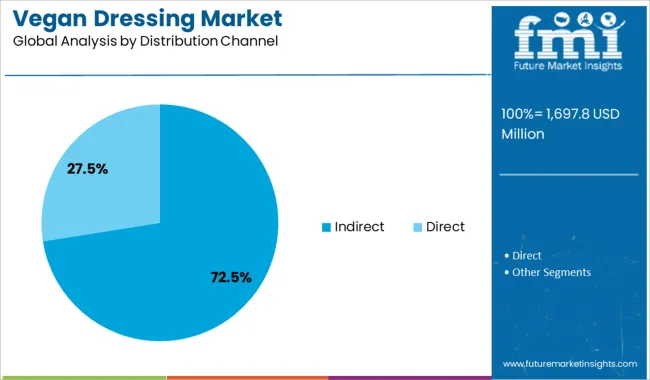
The indirect distribution channel segment is projected to hold 72.5% of the vegan dressing market revenue in 2025, maintaining dominance in market reach. This channel includes wholesalers, distributors, and foodservice suppliers that connect manufacturers with retail stores, restaurants, and institutions.
Growth in this segment has been driven by the extensive network and efficiency of indirect channels in penetrating diverse markets, including supermarkets, specialty stores, and foodservice outlets. Indirect distribution supports volume sales and enables manufacturers to focus on product development while leveraging established logistics networks.
Additionally, the growth of foodservice and catering sectors relying on vegan options has reinforced the importance of indirect channels. As consumer demand for vegan dressings expands across various venues, the indirect distribution channel is expected to sustain its leading role in market delivery.
According to the vegan dressing market analysis report, the year-on-year growth rate of the overall market has increased substantially from that recorded over the years 2020 to 2024.
Concerns regarding health and obesity have contributed to the increasing demand for healthy food items such as salads. They are projected to have a positive effect on the vegan dressing industry. The market is also expected to expand in parallel with the increase in demand for convenience, nutritious, and ready-to-eat food items.
After the emergence of COVID-19, there was an evident disruption in the vegan dressing supply chain, resulting in a market downturn. However, with economies giving chances and rising consumer desire for healthy and nutritious food products, the vegan dressing market trends and forecasts are likely to increase significantly.
Vegan ranch improves food taste and appearance, which is predicted to serve as another driver for future trends in the vegan dressing market. Furthermore, the rising inclination for continental cuisines, where vegan salad dressing is used exhaustively, is projected to fuel demand for vegan dressing during the forecast period (2025 to 2035).
A gradual increase in the lactose intolerant population is expected to influence the sales of vegan dressing, spreads, and sauces over the next half-decade.
Increasing progress in the foodservice industry combined with growing competition and customer awareness is likely to intensify the emerging trends in the vegan dressing market. Furthermore, appealing packaging combined with product innovation is expected to set the future vegan dressing market growth.
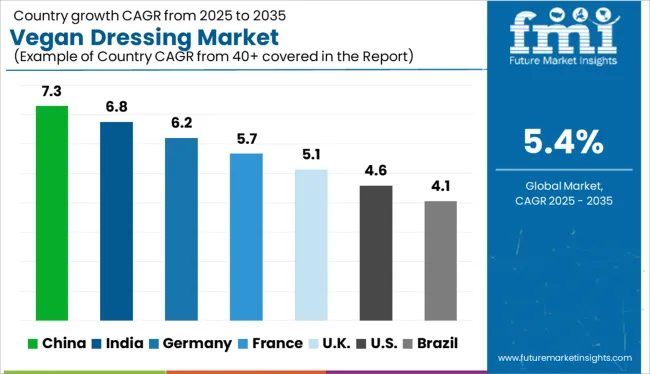
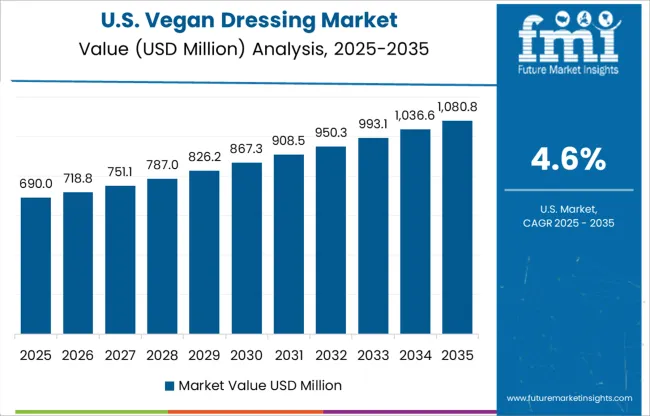
The USA is predicted to gain almost 81% of the total revenue value share of the North American vegan dressing market by the end of 2035. Such higher volume sales of vegan dressing can be attributed to the increasing health awareness among consumers and their urge to switch to healthy eating habits.
This change in habit includes vegetarian and vegan choices of different food items of varied taste preferences creating a favorable ground for the vegan dressing market key trends and opportunities in the USA.
The Asia Pacific region is expected to exhibit a positive prospect for the vegan dressing market growth with the increasing demand for food products with high quality and varied taste profiles in emerging economies of the region. China, India, and Japan are expected to emerge as lucrative markets for vegan dressing producers in the region, mainly attributed to the growing population and their demand for vegetarian fast food options.
India is anticipated to showcase robust growth in the sales of vegan dressing with a CAGR of 4.2% over the forecast period of 2025 to 2035. On the other side, China is projected to gain a significant market share of nearly 30% of the overall East Asian vegan dressing market share by 2025 end.
Demand for vegan dressing for commercial or industrial use is expected to escalate and is likely to account for about 60% value share of the global market by 2025 end.
This is due to the increase in demand for vegan dressing in making sandwiches, burgers, and other fast food items. This segment is also likely to grow at the highest rate and strengthen the vegan dressing market adoption trends in the near future.
In case of distribution channel, the indirect channel is expected to account for a higher vegan dressing market share than that of the direct channel.
Also, in the indirect channel, online retailers are the fastest-growing segment and are predicted to expand their vegan dressing market opportunities in the coming decade.
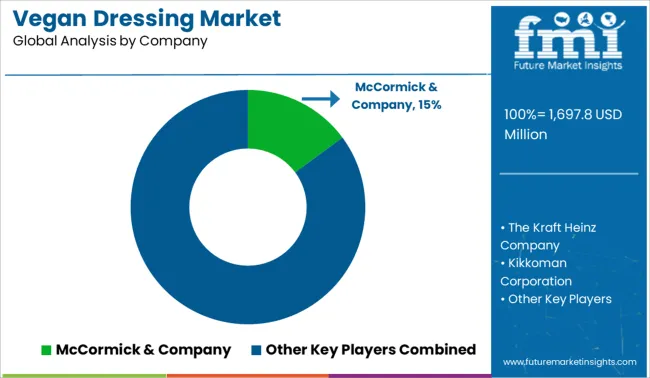
The global vegan dressing market is a moderately competitive market, with tier-1 players holding up to 35% to 40% share of the market. Expansion of the vegan dressing business through mergers, acquisitions, collaborations, and alliances is the primary strategy followed by key players.
Along with a focus on different approaches such as adoption of new technologies to develop innovative products, and enlargement of sales channels, has created a larger customer base propelling the vegan dressing market key trends.
For instance, Kraft Heinz has collaborated with the Food Network to launch a range of salad dressings, meal kits and cooking sauces. The new product line called Food Network Kitchen Inspirations is aimed at encouraging customers to play in their home kitchens with global flavors including oil free salad dressing.
| Attributes | Details |
|---|---|
| Market Size Value in 2025 | USD 1697.8 million |
| Market Forecast Value in 2035 | USD 2872.7 million |
| Global Growth Rate | 5.4% |
| Forecast Period | 2025 to 2035 |
| Historical Data Available for | 2020 to 2024 |
| Market Analysis | MT for Volume and USD Million for Value |
| Key Regions Covered | North America; Latin America; Europe; East Asia; South Asia; Oceania and MEA |
| Key Countries Covered | United States, Canada, Brazil, Mexico, Germany, UK, France, Italy, Spain, Nordic, Russia, Poland, China, India, Thailand, Indonesia, Australia and New Zealand, Japan, GCC countries, North Africa, South Africa, others. |
| Key Market Segments Covered | Product Type, Application, Distribution Channel, and Region |
| Key Companies Profiled | McCormick & Company; The Kraft Heinz Company; Kikkoman Corporation; ConAgra Food Inc.; Sweet Baby Ray’s; Litehouse, Inc.; Red Duck Foods, Inc.; Majestic Garlic; Bear Pond Farm; KENSINGTON & SONS; Follow Your Heart; Daiya Foods Inc.; Meridian Foods Limited; Amy's Kitchen, Inc.; B&G Foods, Inc.; Other Players |
| Pricing | Available upon Request |
The global vegan dressing market is estimated to be valued at USD 1,697.8 million in 2025.
The market size for the vegan dressing market is projected to reach USD 2,872.7 million by 2035.
The vegan dressing market is expected to grow at a 5.4% CAGR between 2025 and 2035.
The key product types in vegan dressing market are vinaigrettes, mayonnaise, ranch dressing, blue cheese, caesar dressing and other creamy dressing.
In terms of application, residential segment to command 33.6% share in the vegan dressing market in 2025.






Full Research Suite comprises of:
Market outlook & trends analysis
Interviews & case studies
Strategic recommendations
Vendor profiles & capabilities analysis
5-year forecasts
8 regions and 60+ country-level data splits
Market segment data splits
12 months of continuous data updates
DELIVERED AS:
PDF EXCEL ONLINE
Vegan Salad Dressing Market - Growth & Demand 2025 to 2035
Vegan Vitamin D3 Supplements Market Size and Share Forecast Outlook 2025 to 2035
Vegan Cheese Market Size and Share Forecast Outlook 2025 to 2035
Vegan Confectionery Market Size and Share Forecast Outlook 2025 to 2035
Vegan Steak Market Size and Share Forecast Outlook 2025 to 2035
Vegan Pasta Market Size and Share Forecast Outlook 2025 to 2035
Vegan Hyaluronic Acid Market Size and Share Forecast Outlook 2025 to 2035
Vegan Collagen Peptides Market Size and Share Forecast Outlook 2025 to 2035
Vegan Collagen Skincare Market Size and Share Forecast Outlook 2025 to 2035
Vegan Protein Powder Market Analysis - Size, Share, and Forecast 2025 to 2035
Vegan Tortillas Market Size and Share Forecast Outlook 2025 to 2035
Vegan Casing Market Size and Share Forecast Outlook 2025 to 2035
Vegan Cheese Sauce Market Size and Share Forecast Outlook 2025 to 2035
Vegan Dips Market Size and Share Forecast Outlook 2025 to 2035
Vegan Yogurt Market Size, Growth, and Forecast for 2025 to 2035
Vegan Meals Market Size, Growth, and Forecast for 2025 to 2035
Vegan Dog Food Market Analysis - Size, Share, and Forecast Outlook 2025 to 2035
Vegan Chocolate Market Analysis - Size, Share, and Forecast Outlook 2025 to 2035
Vegan Protein Bars Market Analysis – Size, Share & Trends 2025–2035
Vegan Vitamins and Supplements Market – Growth & Demand 2025 to 2035

Thank you!
You will receive an email from our Business Development Manager. Please be sure to check your SPAM/JUNK folder too.
Chat With
MaRIA